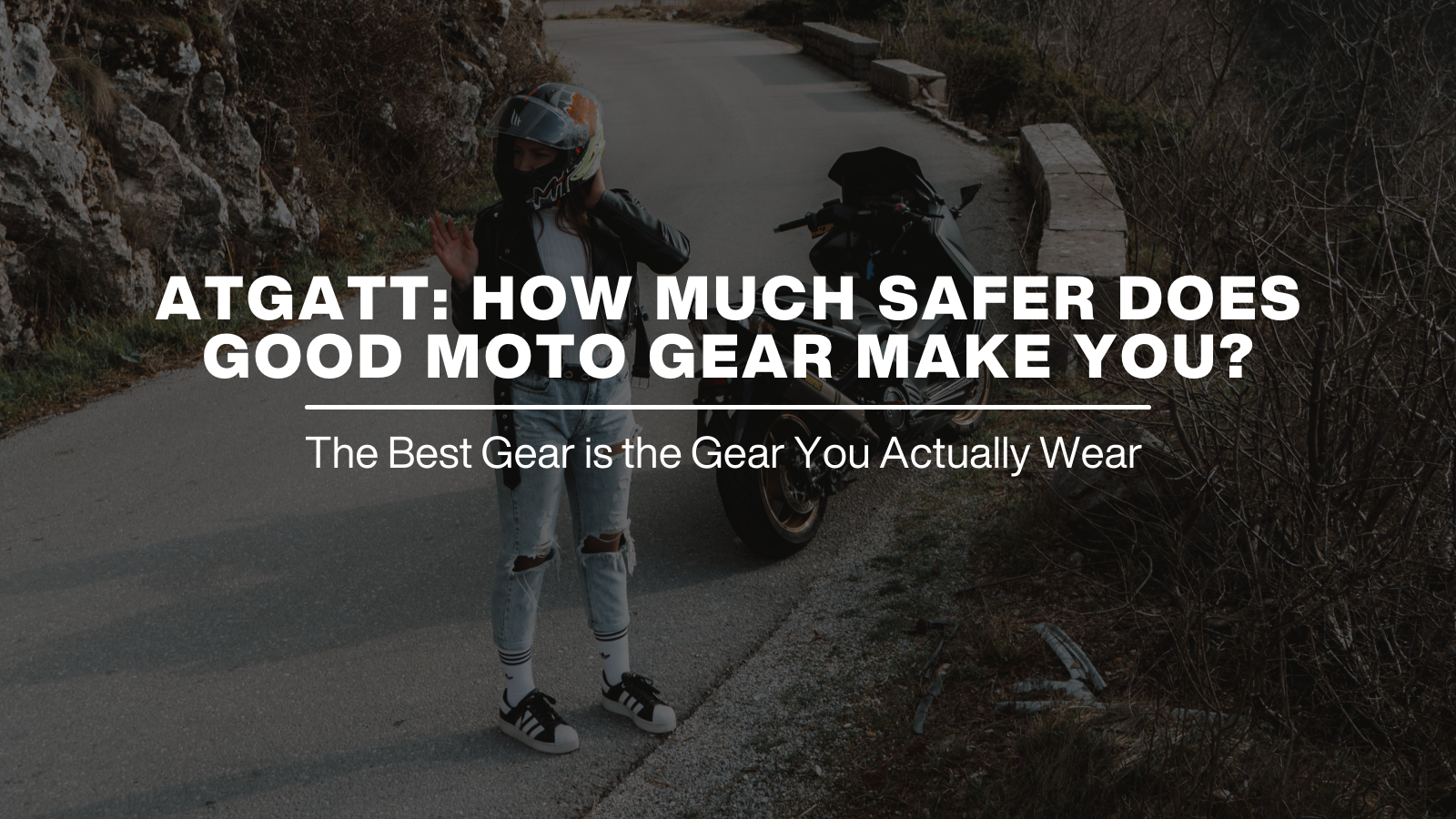ATGATT meaning --All The Gear, All The Time. It's a mantra you'll see online and a mentality every rider should have, no matter how experienced or old school they are.
So how much should you wear? How good should it be? And what will it protect you from?
Let's find out.
What Should You Wear?
ATGATT is clear- wear all of it. But what does that mean?
Most motorcycle safety organizations agree riders should at least have sturdy trousers (motorcycle-specific preferred), a motorcycle-specific riding jacket, a DOT or Snell-foundation approved helmet (full-face protection is obviously best), sturdy boots that won't come off in a crash and cover the ankle bones and a pair of gloves.
Here are some things to consider when looking into motorcycle gear:
- Trousers. Jeans are good...for about a second of abrasion resistance. And then they start to tear, exposing your skin to heat and friction. Motorcycle-specific clothing that resists abrasion and tearing is key, as most riders will slide on some part of their legs or butt when they crash. You also need CE-standard armor in the knees and hips in case you come down on those delicate bits. The CE standards ensure the materials, design and construction will provide some protection in a crash. Anything else? Maybe it works, or maybe it doesn't.
- Boots. Any boot is better than sneakers or low-top shoes, so long as it has some means of staying firmly on your feet. The unlaced look is cool, but your boot flying through the air, leaving your little sock-clad feetsies to absorb all that impact and abrasion energy alone isn't something you'll want to see.
- Gloves. Like boots, any glove is better than none, even cheap leather work gloves. Motorcycle gloves, though, are even better. They'll stay on in a crash, resist abrasion, possibly provide some impact protection and have features suitable for the kind of riding you'll be doing.
- Jacket. A modern motorcycle jacket is purpose-built with three important features: impact resistance, abrasion resistance and temperature adaptability. Modern designs use tough, washable, water resistant or waterproof textiles that offer similar abrasion resistance (at least pound-for-pound) at a much more reasonable price point than leather. It's also is lighter, fits better compared to off-the-rack leathers and is usually packed with zippered vents and plenty of room to layer insulating garments underneath. And pockets! So many pockets you'll probably lose things.
- Ear Plugs (we're not saying that because we sell ear plugs. Well, maybe a little). But seriously, high-fidelity hearing protection lowers wind noise without muffling what you need to hear to stay alert, like traffic and in-helmet comms. There are easy ways to ride safer without sacrificing the thrill. Safety without sacrifice. the thrill of the ride. Not to mention, the right ear plugs can make your ride more comfortable, helping you ride longer & safer.
- Helmet. Do we have to explain this one?
When Should You Wear It?
When we say ATT we mean All The Time. Cruising down to the beach on my little scooter that doesn't count, right? Or just riding across town at 25 mph? Or what if I'm riding my Harley and all my bros are just wearing their vests?
Let's be clear- ATGATT doesn't care how far you're going or how long you're riding for a long time. Distance has no effect on the likelihood of a crash per miles traveled—in fact, the closer you are to home the more likely you are to crash. And no, moving doesn't help. We tried.
Look at it this way—if you knew you were going to crash today, you probably wouldn't get on your bike unless you're a moron (in which case there's no way you would have read this far).
To paraphrase a great sage, that's why they call them 'accidents.' They're unplanned, unexpected events. And you don't know how bad they'll be either.
So if you wear a leather jacket with jeans (which rip like paper on asphalt), you're betting you'll somehow avoid touching the lower part of your body to the ground, a bet no bookmaker would make odds against.
No gloves? Make sure you remember to tuck your hands under your armpits before you hit the ground.
The point is, you just don't know what will happen or when. Wearing true ATGATT gear means you're prepared for a reasonably broad range of possible crash scenarios, including sliding, tumbling, flying through the air and hitting solid objects, and we're not trying to be funny—this is all stuff that's happened to us.
Sure, your gear should match the style of riding, climate and conditions, but the protective properties should be way at the top of the list of considerations.
Just Do It.
If you're not in the habit of being ATGATT, consider changing your lifestyle a bit to make it happen. We won't lie to you—it can be inconvenient and uncomfortable, but after a while it becomes second nature and you stop thinking about it. And then one day, you'll see someone riding on the freeway in a t-shirt and shorts and cringe.
Hopefully, you'll never need the basic safety gear we discuss in this article, but if you do (and most of us, unfortunately, will) you will be so glad you have it.
Until that day, ride safe!





Share:
5 Summer Motorcycle Riding Hacks
LOOKING BACK: 8 BEST VIRTUAL LIVE MUSIC OF THE PANDEMIC ERA